The Ultimate WordPress Form Plugin List 2024
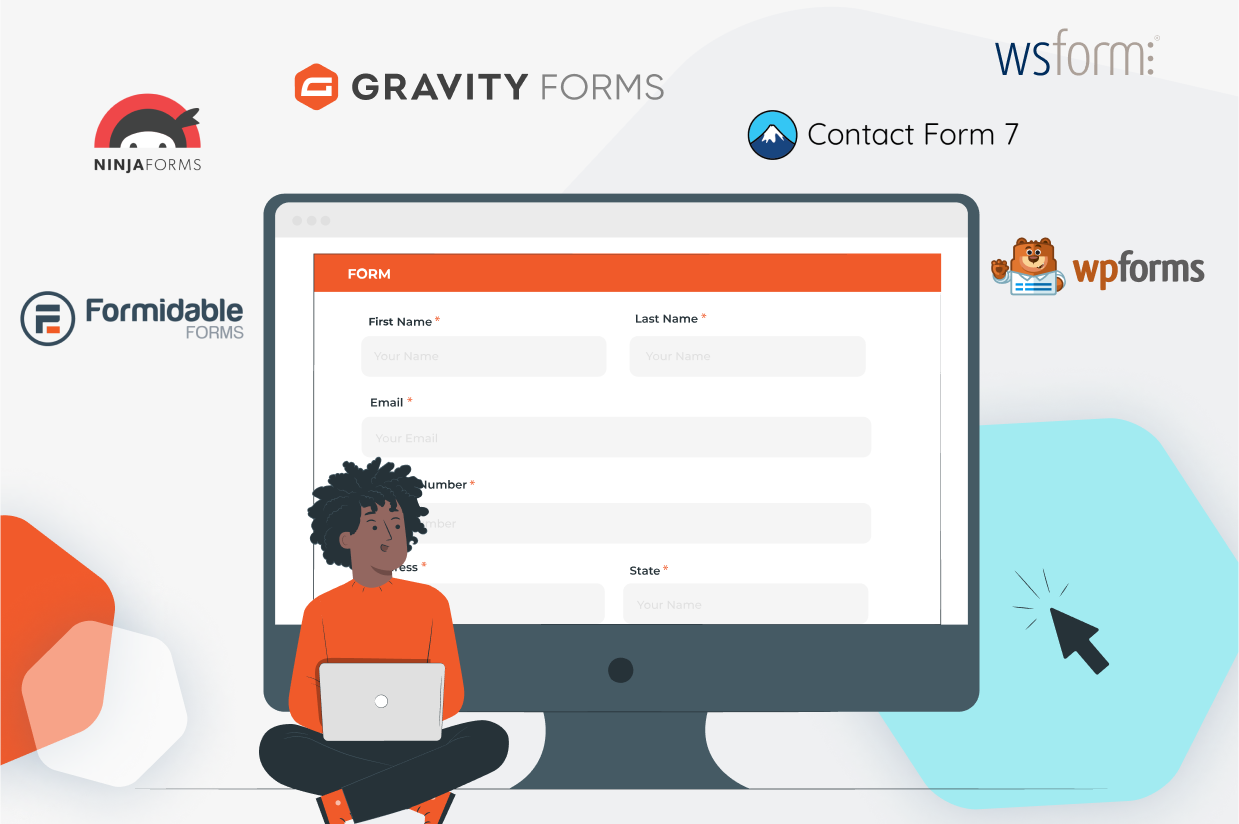
Searching for the right WordPress form plugin for your next project?
Pretty much every WordPress website needs at least one form. And that fact has led to an abundance of options when it comes to form plugins.
With all those options, which ones should you consider?
By listing out 15 form builders for you, we aim to tackle that topic. And while 15 might still seem like a lot of choices, it’s still easier to browse through than the 2,000+ options that appear if you search “form builder” at WordPress.org!
While we can’t go into deep detail on each plugin, we’ll try to hit the highlights so that you have a decent idea of where to start for your use case.
Before we get to the list, let’s quickly run through a few key areas that you’ll want to consider when choosing a form plugin for your site…
What to Consider When Choosing a Form Plugin
- Ease of use – you’ll want to make sure your form plugin is easy to use, especially if you’re not a developer. Most modern form plugins offer drag-and-drop builders, but not all drag-and-drop builders are made equal (and some popular plugins still don’t offer one).
- Types of forms that you want to build – if you just want to build a simple contact form, pretty much any plugin can get the job done. But if you want to get into payment forms, registration forms, lead gen forms, and so on, you’ll want to make sure that your chosen plugin offers robust functionality in those areas.
- Budget – while free form plugins can work for simple use cases, you’ll probably need to pay if you’re going beyond basic contact forms. Don’t just look at the first-year price, either. Consider the long-term cost of ownership, especially because some popular form plugins raise prices after the first year.
- Integrations with other services – if there’s a specific service that you want to integrate your forms with, you should make sure the form plugin supports that service. For example, if you want to add people to your ConvertKit list, make sure your form plugin supports ConvertKit. If you want to use Square for payments, make sure your form plugin supports Square (as some only support Stripe and PayPal).
- Third-party extension marketplace – third-party extensions let you add features and integrations beyond those that come from the form plugin developer, so they can be really useful for more custom implementations. Some plugins will have large marketplaces with lots of options, while others have very few (or maybe zero) options.
- Customer support – for free plugins, you’ll typically need to rely on the WordPress.org support forums. For premium plugins, you should expect one-on-one support, typically delivered via ticket or email.
Of course, your website might have unique needs that go beyond this list. But in general, thinking about those areas should help set you up for success.
The Best WordPress Form Plugins to Consider for Your Next Project
With 15 different plugins installed on our demo site (well, technically ~12 for reasons that will become clear in the list), we are ready to dig into the wonderful world of WordPress form plugins…
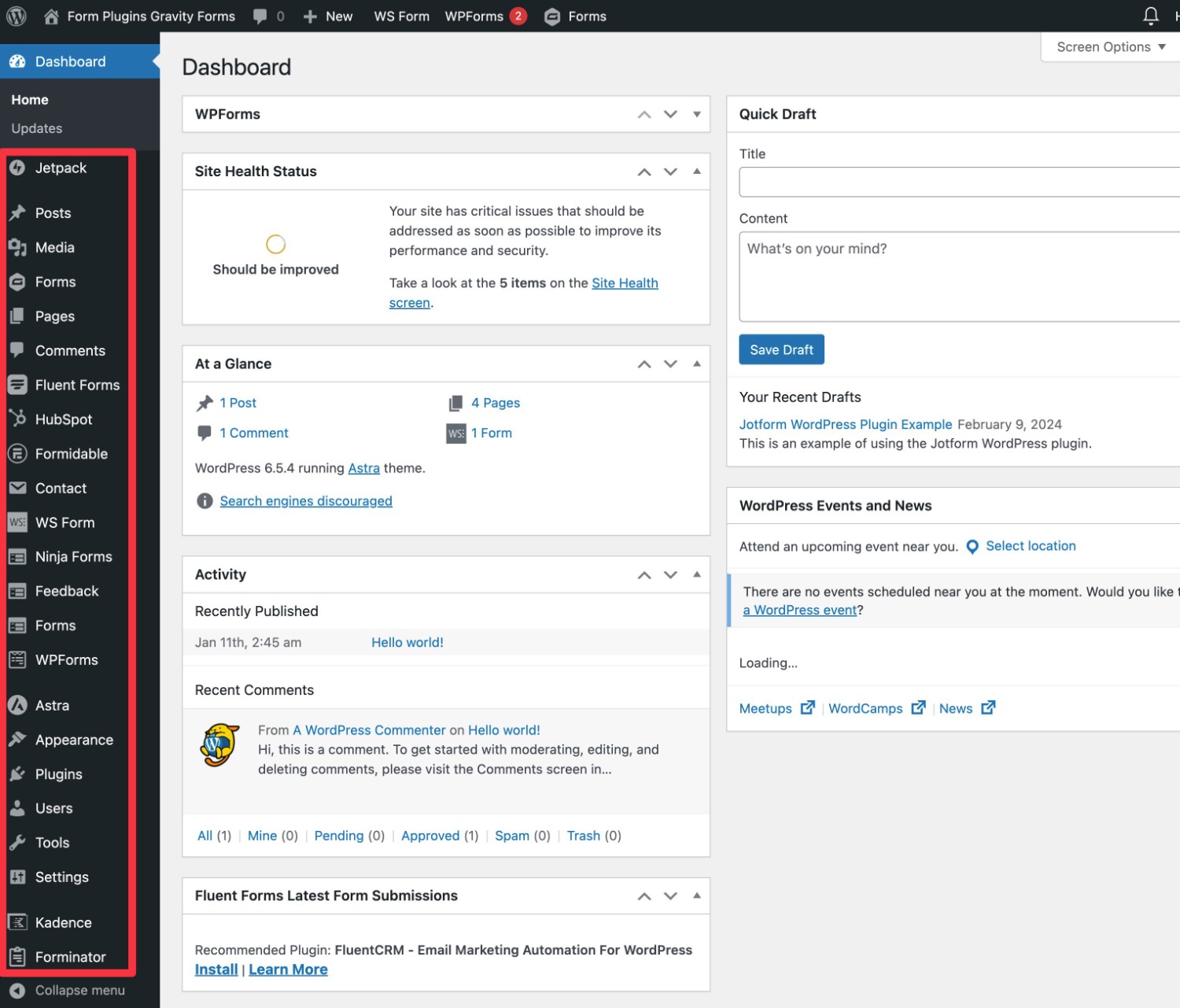
With the exception of the first entry on our list (explained below), these are not in any particular order and the numbering of the list should not be taken as a ranking of which plugin is “better”.
1. Gravity Forms
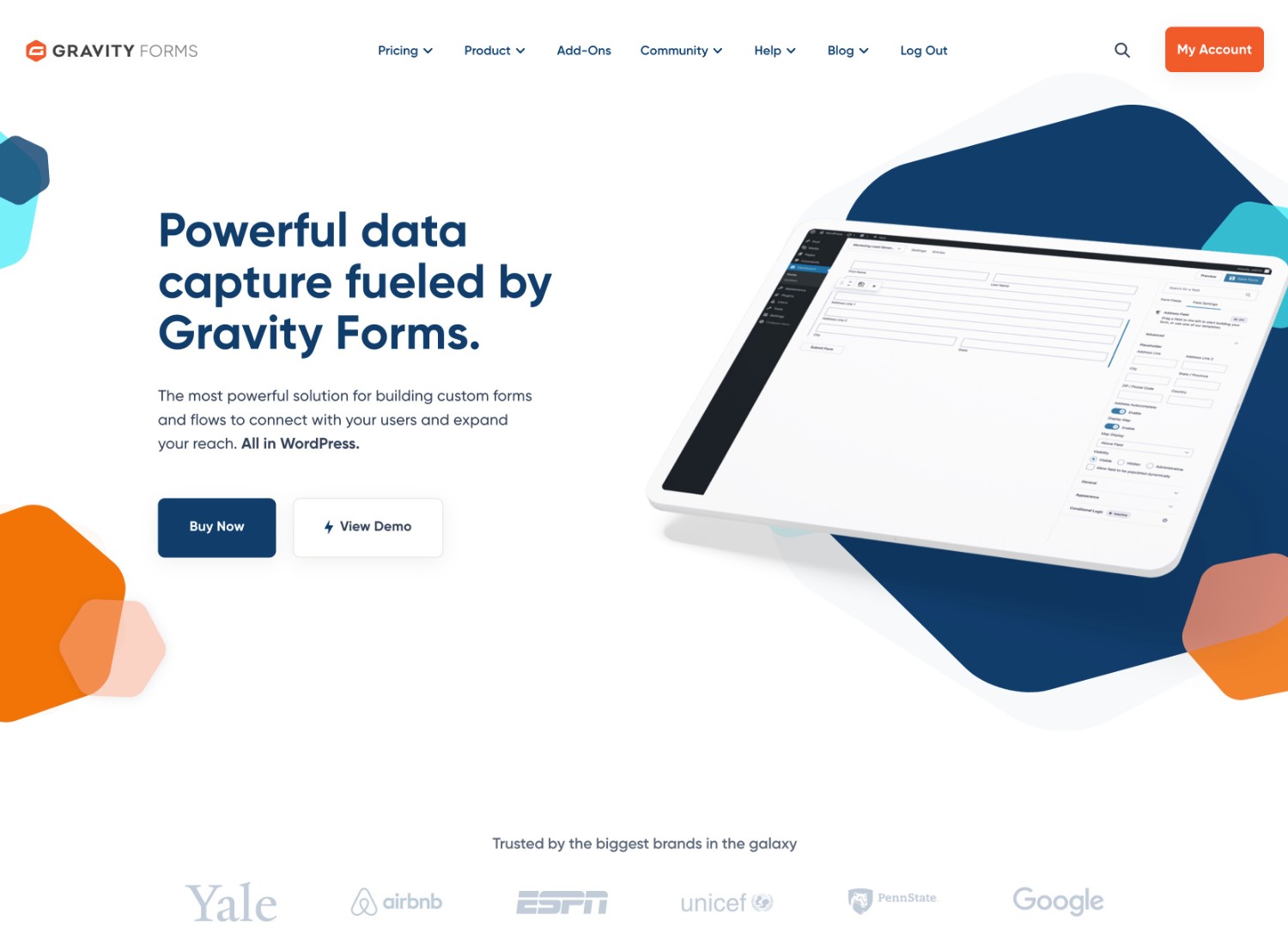
Full disclosure – if you missed the logo at the top of this page, we want to make it clear that you’re on the Gravity Forms blog. That is, we make the Gravity Forms plugin.
And yeah, we think that Gravity Forms is the best form plugin for most people. We wouldn’t spend a bunch of time working on it if we didn’t.
With that being said, Gravity Forms is not the only high-quality form plugin out there, which is why there are 14 other options on this list. We’d be sticking our heads in the sand if we said that there are zero situations in which one of those plugins could be a better option for you.
Here’s why we think Gravity Forms can be the best option for a lot of WordPress users, though.
First off, Gravity Forms gives you the flexibility to build pretty much any form type imaginable using a non-technical interface, from simple contact forms to payment forms, registration flows, surveys, legal signing forms, and lots more.
Beyond that, you get lots of opportunities to add custom functionality and integrate with the other tools that you’re using. For example, payment processors, CRMs, email marketing services, project management software, customer support software, and so on.
In addition to the large lists of built-in features and integrations, Gravity Forms also has a huge marketplace of third-party extensions that give you even more options. And if that’s not enough, you also have lots of options for building your own solutions (or hiring a developer to do it for you), including a PHP API and a REST API.
Basically, if your use case involves some kind of form on WordPress, Gravity Forms can probably help you implement it without requiring any custom development (though you can do that if you want to).
Key Details
- Types of forms: You can use it for pretty much any type of form, including contact forms, lead gen forms, payment forms, surveys, and lots more.
- Integrations with other services You can integrate Gravity Forms with tons of services including payment processors, CRMs, email marketing services, Zapier, Trello, and more. There’s also a webhooks add-on which gives you even more flexibility, along with the Gravity Forms REST API.
- Third-party add-on marketplace: Gravity Forms has one of the largest third-party extension marketplaces of any form plugin. You can find hundreds of add-ons to give you new features, integrations, and more. The Gravity Forms Certified Add-Ons program can also give you confidence in using some of these add-ons because the code quality has been verified by the Gravity Forms team.
- Support: You get access to one-on-one ticket support with all license types.
Form Builder Interface
Gravity Forms offers a visual, drag-and-drop form builder that gives you a no-code way to build your forms.

Pricing
Gravity Forms only comes in a premium version. Prices start at $59 for the Basic license and range up to $259 for the Elite license. There’s also a special $129 Nonprofit license.
2. WPForms

WPForms is a popular form plugin that’s owned by Awesome Motive, the company behind a number of popular plugins.
Part of its popularity comes from the fact that it’s a quality plugin. But another part of its popularity comes from the fact that the plugin comes pre-installed with a lot of web hosts and theme auto-installers.
We have a full Gravity Forms vs WPForms comparison that covers the plugin in more detail, but here are the high points…
Key Details
- Types of forms: You can use it for pretty much any type of form, though you’ll need one of the premium licenses for most use cases.
- Integrations with other services: You can integrate with most popular payment processors, email marketing services, and CRMs. There are also Zapier and webhooks add-ons if you need more flexibility.
- Third-party add-on marketplace: While you can find some third-party extensions, the marketplace isn’t that large when you compare it to the popularity of the plugin.
- Support: With a paid WPForms license, you can get one-on-one ticket support.
Form Builder Interface
WPForms offers a visual, drag-and-drop builder interface that’s very easy to use.
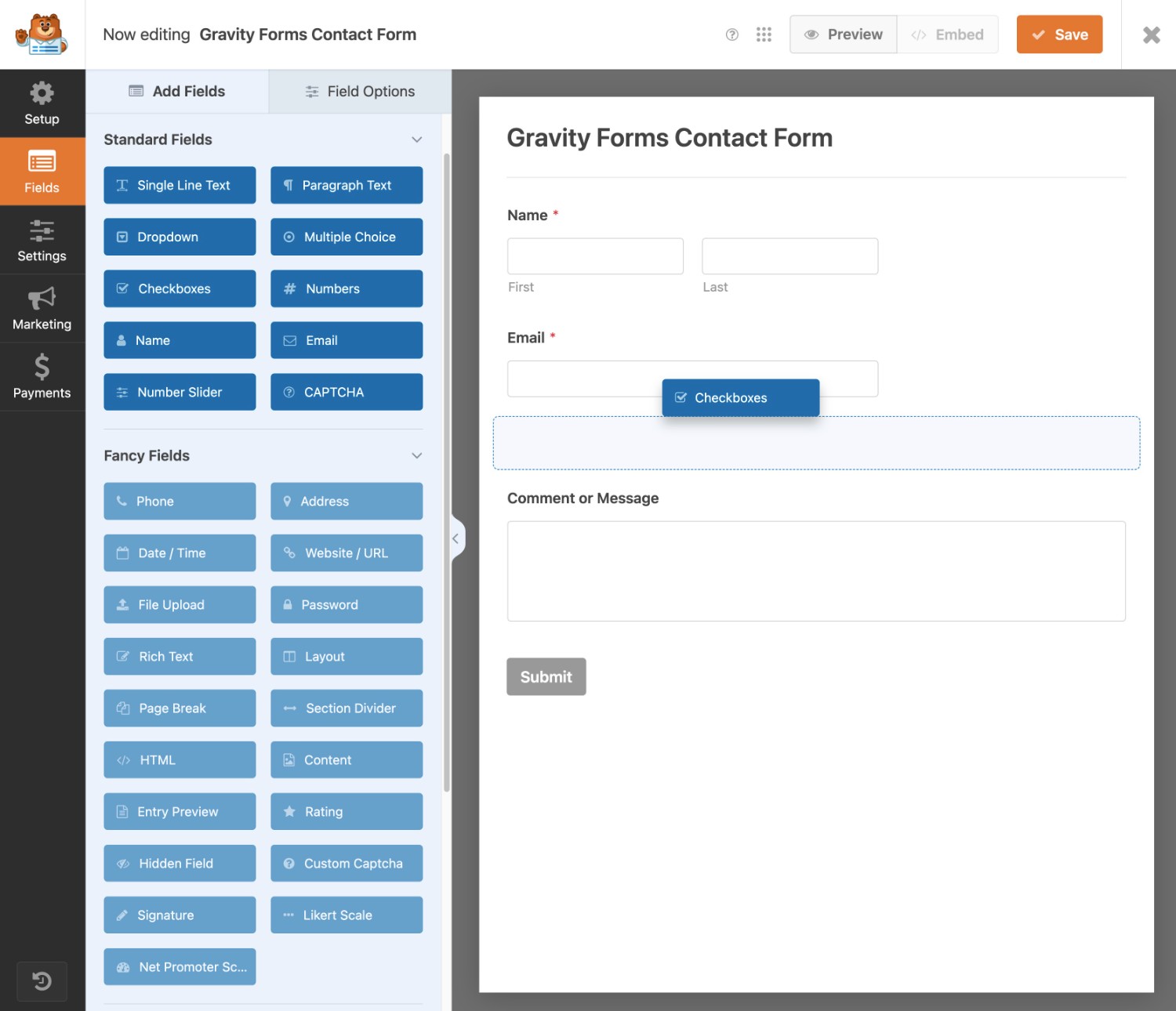
Pricing
WPForms has a free version at WordPress.org. The free version doesn’t save form submissions to your database/let you view them in your WordPress dashboard, though, which is something most other free plugins offer.
The premium versions are some of the most expensive on this list, starting at $99 for the Basic license and going up to $599 for the Elite license.
You can usually get ~50% off those prices for the first year, but your license will renew at the full price after the first year, so you should budget for the full cost.
3. Fluent Forms

Fluent Forms is a form plugin from WPManageNinja, which makes other popular plugins like FluentCRM and Ninja Tables.
It has a free version at WordPress.org and then a premium version that adds more functionality.
One of the standout things about Fluent Forms is the affordability of its premium version. Unlike most form plugins, it offers all the premium features even on the cheapest license.
Of course, there are also some tradeoffs in exchange for those cost savings, which we cover in our Gravity Forms vs Fluent Forms comparison.
Key Details
- Types of forms: You can build most common types of forms, though many use cases require the Pro version.
- Integrations with other services: Fluent Forms integrates with most popular services when it comes to payment processors, email marketing services, and CRMs. It also has some unique chat-based integrations, such as connecting to Discord and Telegram Messenger.
- Third-party add-on marketplace: While you can find some third-party add-ons, there’s not a very large marketplace of them.
- Support: With a paid license, you can get support via ticket on all plans.
Form Builder Interface
Fluent Forms offers a visual, drag-and-drop interface to set up your forms.
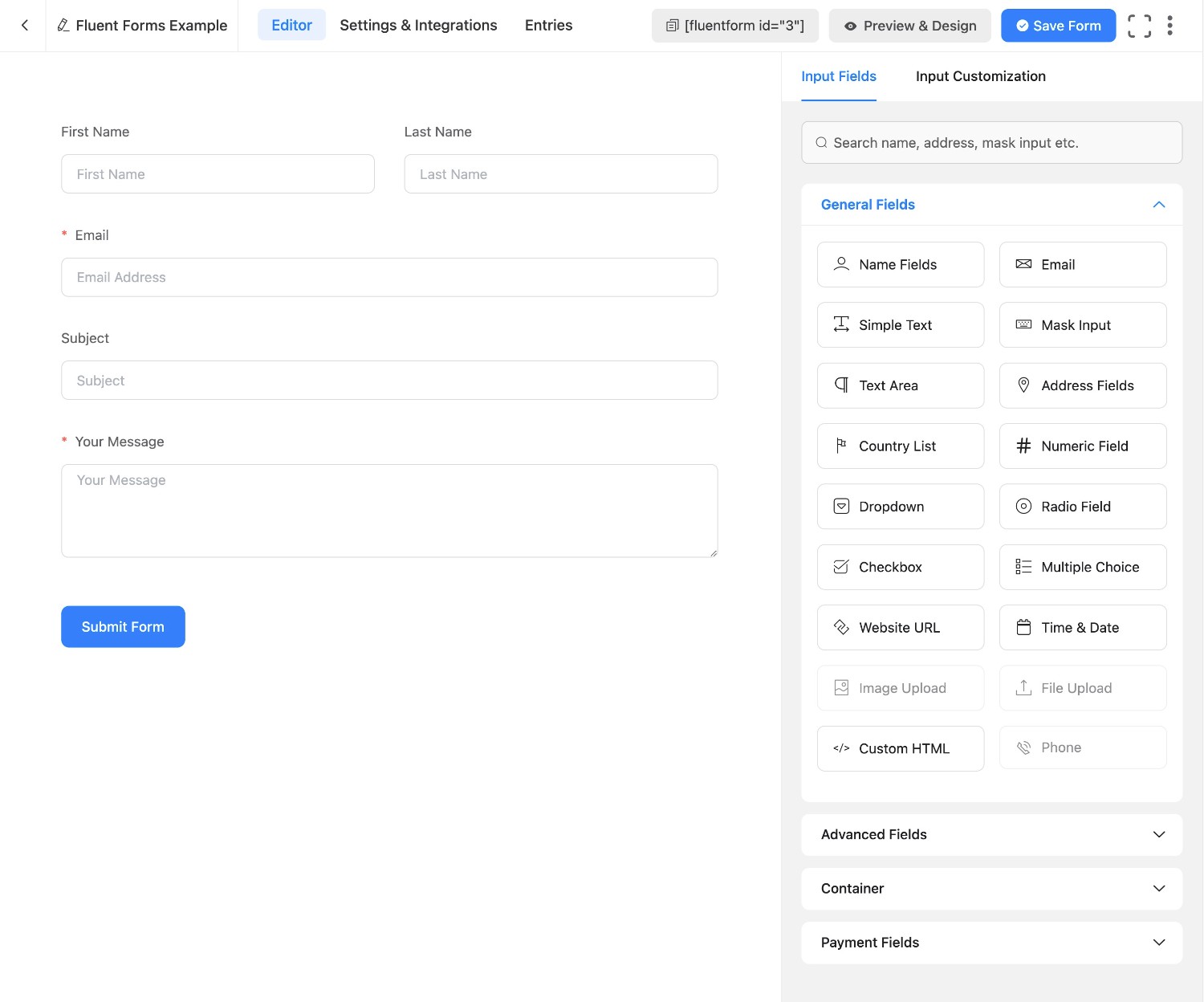
Pricing
Fluent Forms has a free version at WordPress.org.
The premium version starts at $79 for use on a single site and ranges up to $299 for use on unlimited sites. There are also lifetime license options.
4. Formidable Forms

Formidable Forms is another popular form plugin that’s part of the Awesome Motive family via the WPBeginner Accelerator program. While it’s still independent from WPForms, you’ll often see Formidable Forms co-marketed alongside WPForms on Awesome Motive’s websites because of this connection.
Formidable Forms generally excels when it comes to more advanced use cases. For example, it has its own REST API solution like Gravity Forms and it comes with a built-in frontend view builder.
If you want to learn more about Formidable Forms, you can browse our full Gravity Forms vs Formidable Forms comparison.
Key Details
- Types of forms: You can use Formidable Forms for pretty much any type of form, though most use cases require the premium version.
- Integrations with other services: While Formidable Forms integrates with most big-name services, the integration list is not as robust as some other plugins. For example, it lacks built-in integrations with Square or Mollie for payment processing. The Zapier, webhooks, and REST API let you set up additional integrations, though.
- Third-party add-on marketplace: You can find a decent number of third-party add-ons, though not as many as something like Gravity Forms. For example, there are third-party extensions to add integrations for Square and Mollie.
- Support: With a paid license, you get access to one-on-one support via ticket.
Form Builder Interface
Formidable Forms offers a visual, drag-and-drop builder that’s very easy to use.

Pricing
Formidable Forms has a free version at WordPress.org, but most of the standout features require the premium version.
The premium plans start at $79 for the Basic license and go up to $599 for the Elite license. As with WPForms, you can usually get a ~50% discount on the first-year price, but your renewals will still cost full price.
5. Ninja Forms

Ninja Forms is another well-established form plugin that can work for a variety of use cases, from basic contact forms to payment forms, lead gen forms, and more.
One unique detail about Ninja Forms in comparison to the previous plugins is its pricing model. To access premium functionality, you have the option of purchasing individual add-ons or a bundle of some/all of the add-ons.
If you want a deeper look, you can read our full Gravity Forms vs Ninja Forms comparison.
Rundown of the Key Details
- Types of forms: You can build most common types of forms, though you’ll need premium add-ons for many use cases.
- Integrations with other services: Ninja Forms offers a solid integration list, connecting with most popular email marketing services, CRMs, and so on. However, it does lack official integrations for Square and Mollie for payments.
- Third-party add-on marketplace: You can find a solid number of third-party add-ons at WordPress.org. It’s not as many as Gravity Forms or Contact Form 7, but it is more than many other form plugins.
- Support: With a paid license, you can get one-on-one support from the Ninja Forms team. Ninja Forms also offers support to free customers, but the scope is primarily limited to bugs or other issues in the plugin itself.
Form Builder Interface
Ninja Forms offers a visual, drag-and-drop form builder. It shows a full-width visual view at first and then you can add and customize fields using a floating panel.
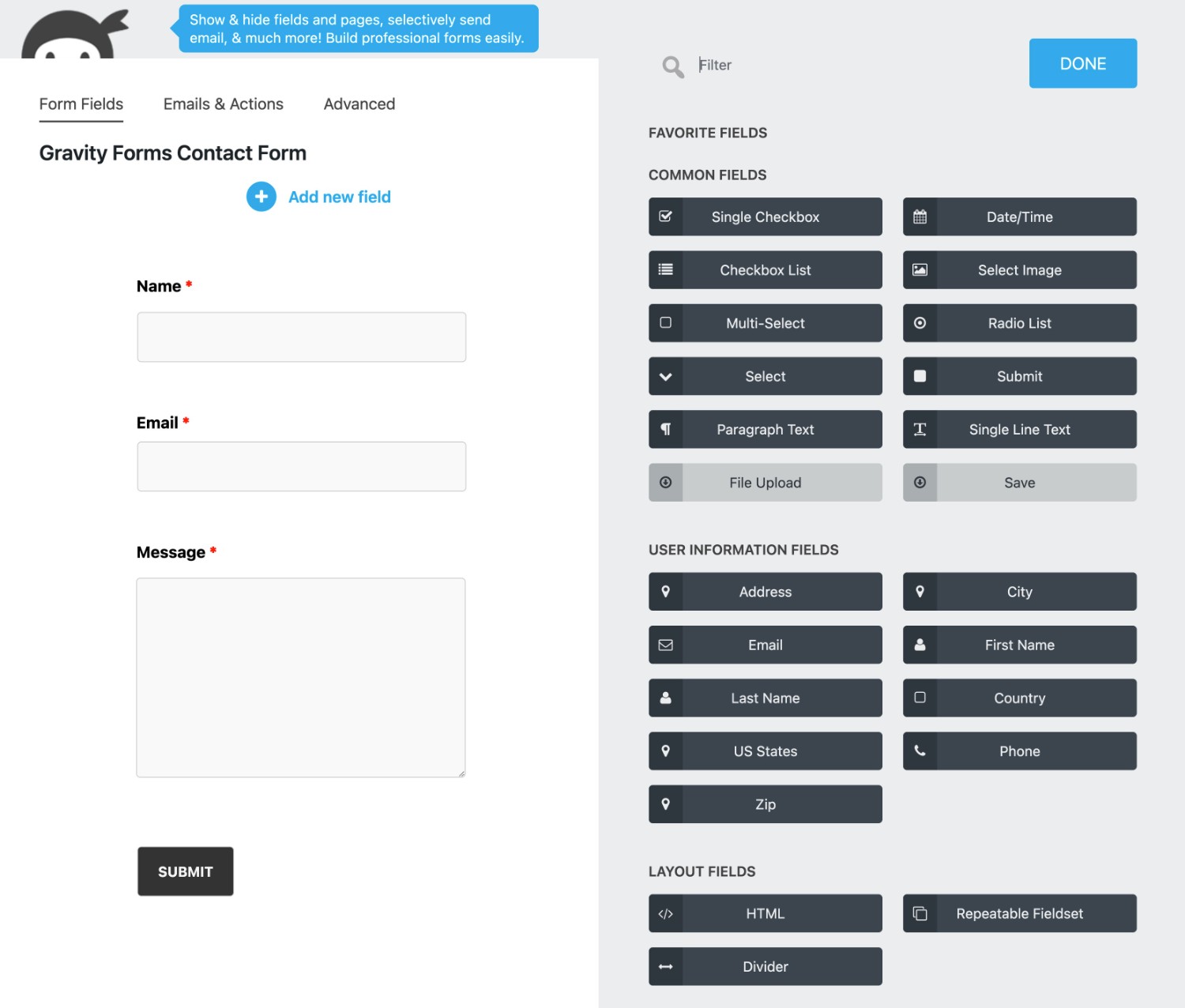
Pricing
The core Ninja Forms plugin is available for free at WordPress.org.
You can then access premium features via add-ons, which you can purchase individually or as part of bundles.
Individual add-ons generally cost $49 for use on a single site, though some are priced differently. Then, there are three bundles which range from $99 to $499.
6. Typeform

Typeform is a SaaS form builder tool, rather than a native WordPress plugin. However, it’s quite easy to integrate into your WordPress site and also offers a dedicated integration plugin, so we think it’s still worth including in the list (even if we are bending the definition of “plugin” a bit).
Other than that, the most unique thing about Typeform is the form interface that your visitors will interact with. Rather than using a traditional web form interface, Typeform uses a conversational interface* where visitors will respond to one question at a time, sort of like a slideshow.
*A number of native WordPress form plugins also support this type of interface, including Gravity Forms, WPForms, Fluent Forms, and some others.
If you want to learn more, we have a whole post comparing Gravity Forms vs Typeform.
Key Details
- Types of forms: All of the forms must use the conversational interface, but you can generally create most common form types. However, it doesn’t work as well for WordPress-specific forms (e.g. registration or content creation).
- Integrations with other services: Typeform offers a good selection of built-in integrations. However, because it’s a SaaS tool, it’s a bit difficult to integrate with tools that aren’t on the list (though you do get some APIs to help you do that).
- Third-party add-on marketplace: There’s no third-party add-on marketplace.
- Support: Typeform offers ticket support on all paid plans, as well as live chat support on the higher-tier plans.
Form Builder Interface
Because of its unique frontend conversational interface, the backend Typeform builder also uses a unique approach that looks more like a slideshow builder.
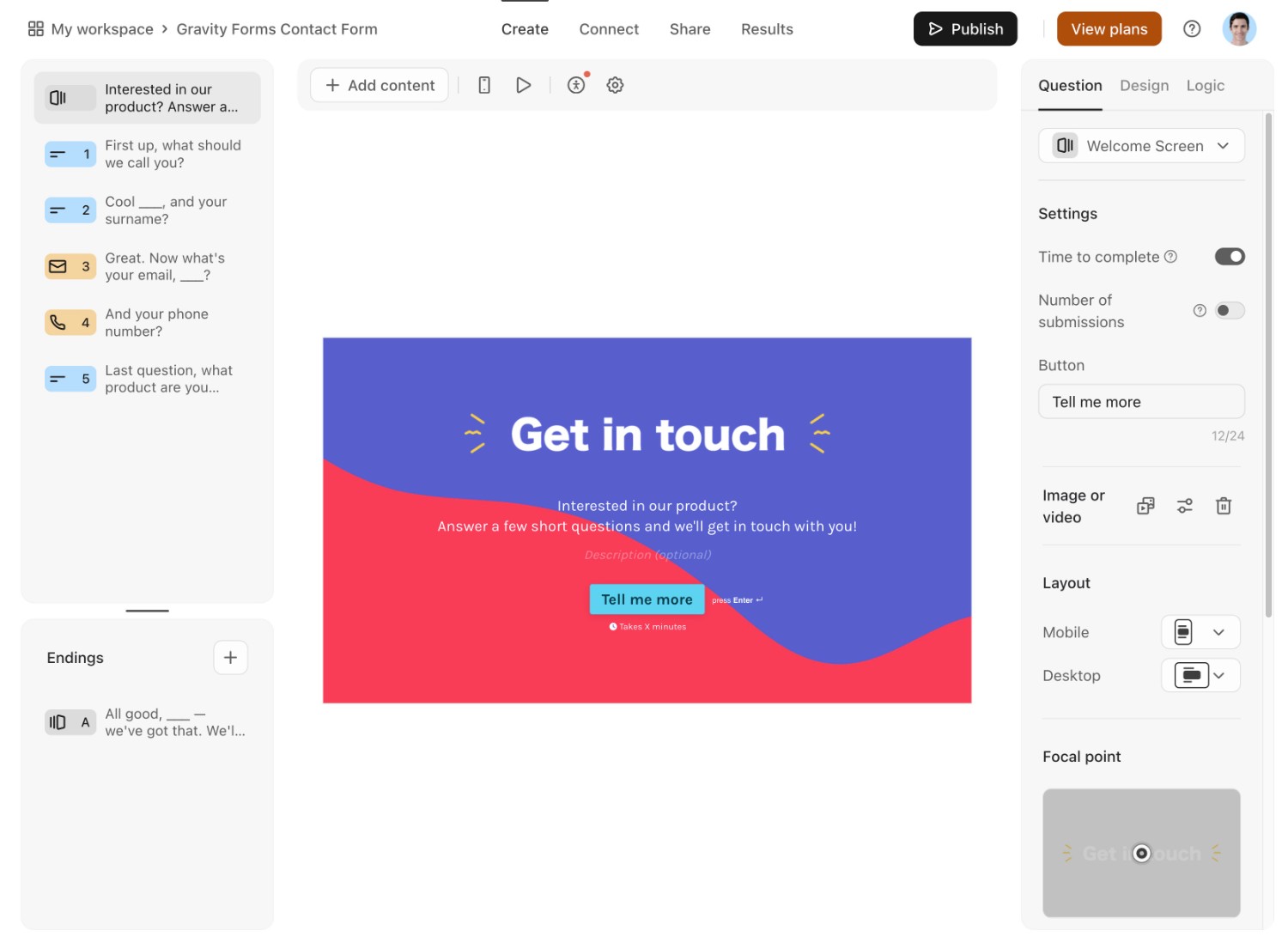
Pricing
Typeform has a limited free plan. With it, you can create forms with up to 10 questions and up to 10 responses per month (in total, across your account).
The paid plans use SaaS-style recurring billing and start at $29 per month for up to 100 responses.
7. Jotform

Like Typeform, Jotform is also a SaaS form builder tool rather than a native WordPress plugin. However, it also offers its own WordPress integration plugins and is just generally easy to use with your WordPress site.
Jotform can excel at building more advanced forms, with things like branching logic and approval workflows.
For a more detailed look, you can read our complete Jotform vs Gravity Forms comparison.
Key Details
- Types of forms: You can use Jotform for most types of forms. However, it’s not a good option for WordPress-specific forms, such as user registration or frontend content creation forms.
- Integrations with other services: Jotform has a pretty strong list of built-in integrations, along with Zapier support. One notable standout is its integrations for project management tools like Notion and Airtable.
- Third-party add-on marketplace: There’s no third-party add-on marketplace.
- Support: Jotform offers 24/7 ticket support on all paid plans.
Form Builder Interface
Because Jotform is technically a SaaS tool rather than a native plugin, you’ll build and manage your forms from the Jotform website.
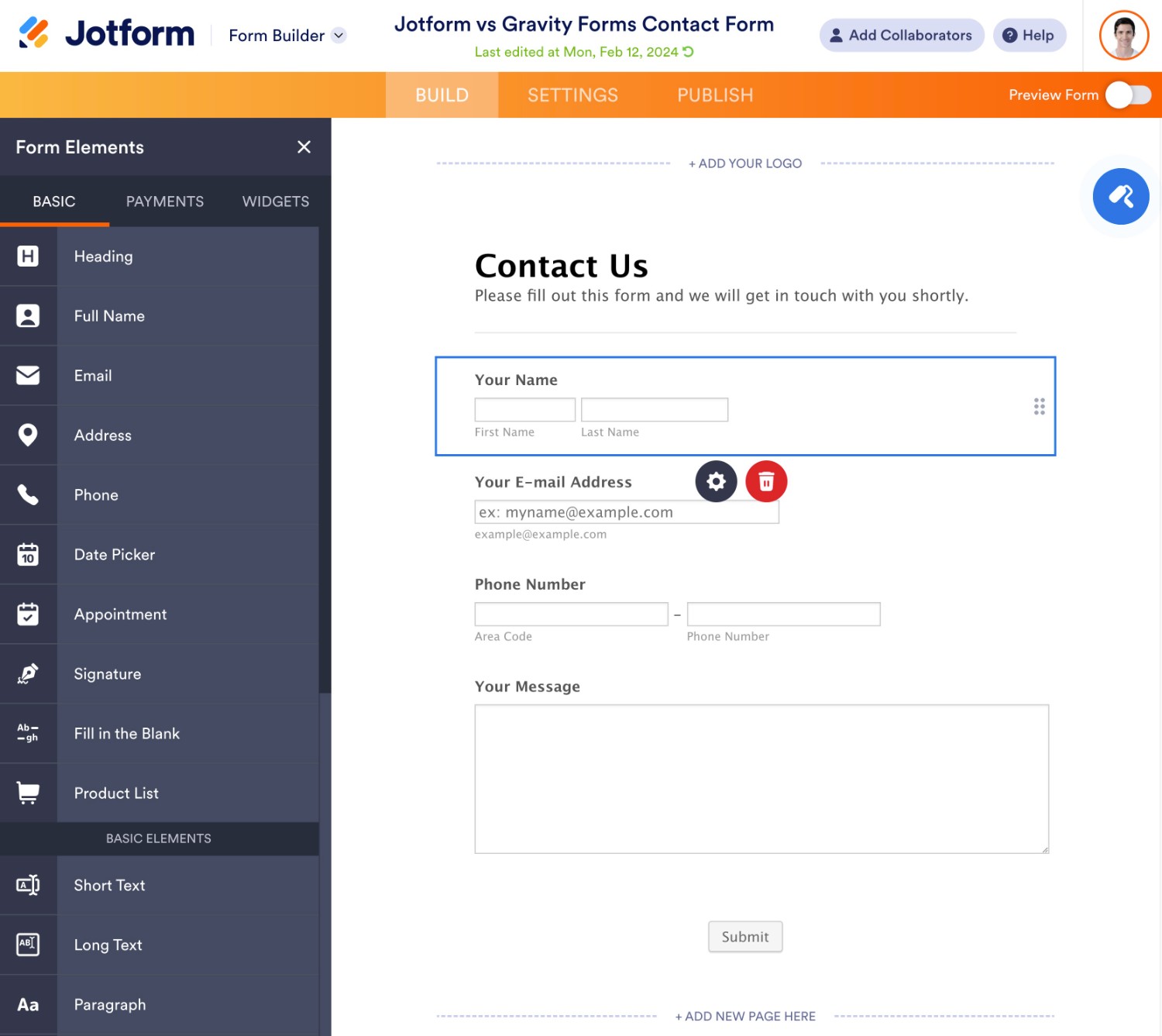
Pricing
Jotform has a free plan that lets you create up to five forms. There are also other limits such as only being able to receive 100 submissions per month and have a maximum of 1,000 form views.
Paid plans use SaaS-style recurring billing and start at $39 per month.
8. Forminator

Forminator is a WordPress form plugin from WPMU DEV, a well-established WordPress company that offers managed hosting, along with lots of other plugins (such as Smush).
One of the standout details about Forminator is how generous its free version is when it comes to the features that it gives you access to. The free version still gives you features like conditional logic, calculations, and multi-step forms, which a lot of other form plugins charge for.
Key Details
- Types of forms: Forminator works for a variety of form types, including payment forms and lead gen forms.
- Integrations with other services: While Forminator does integrate with some popular payment processors and email marketing services, its integration list is shorter than many other plugins. It does support webhooks, though, which gives you some more flexibility and lets you connect it to Zapier (though you’ll need a paid Zapier plan to use webhooks).
- Third-party add-on marketplace: While you can find a few third-party add-ons, there aren’t very many options.
- Support: With a paid plan, you get 24/7 live chat support.
Form Builder Interface
While Forminator does offer a drag-and-drop interface, there’s no visual preview and it feels a little barebones in comparison to many other plugins on this list.
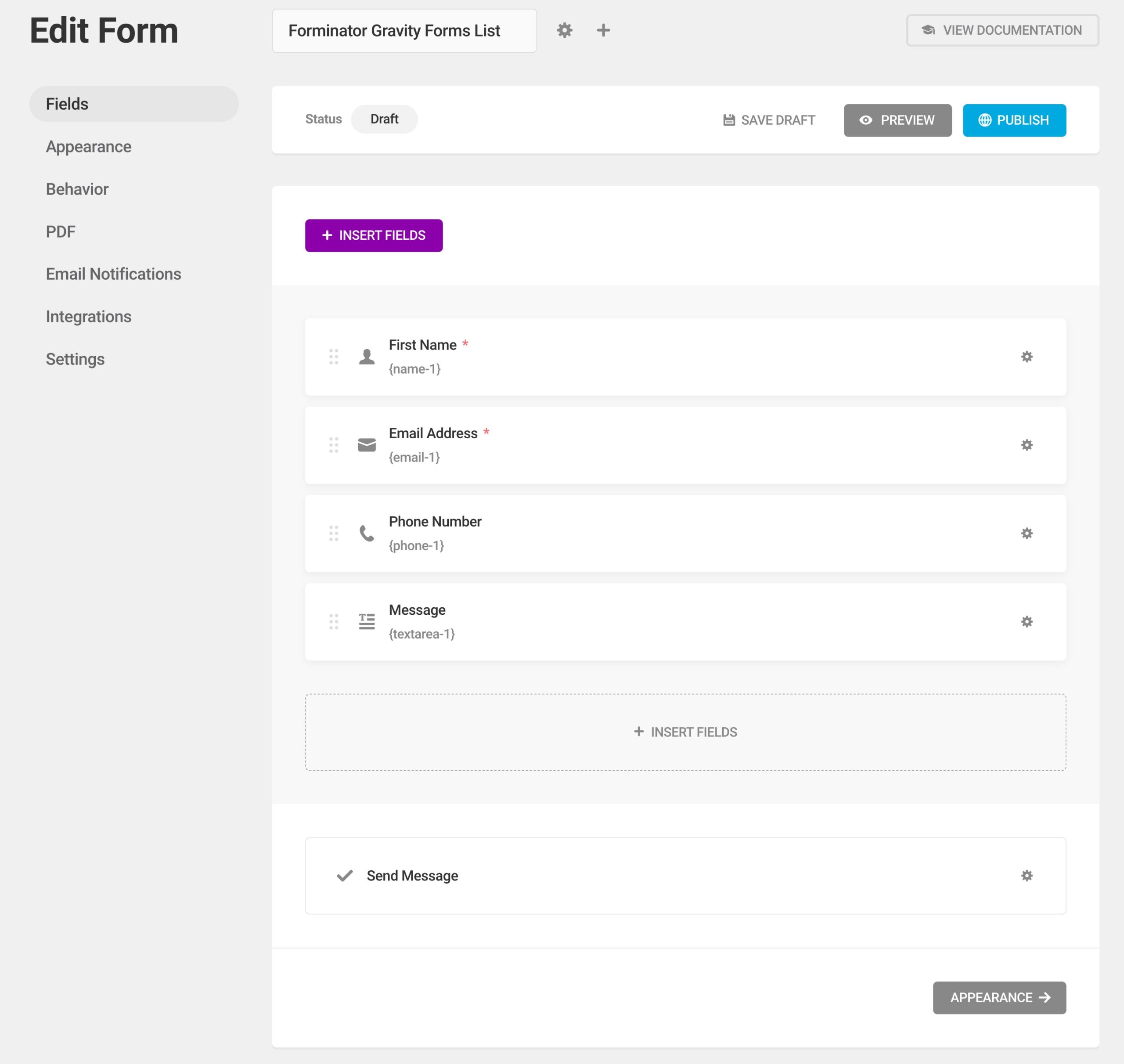
Pricing
Forminator has a generous free version at WordPress.org that’s already pretty capable.
Forminator Pro licenses start at $15 per month, billed annually.
This price gives you access to all the WPMU DEV Pro plugins at no extra cost. So, while it’s expensive for just a form plugin, it might be good value if you’ll use the other plugins from WPMU DEV.
9. Formstack

Like Typeform and Jotform, Formstack is another SaaS form builder tool that you can easily add to WordPress using a code snippet. There is also an official integration plugin, but it’s pretty outdated.
Formstack generally excels when it comes to building workflows and automations powered by your forms, such as new customer onboarding or a loan application. However, because of that advanced focus, its SaaS-style billing can get pretty expensive.
Key Details
- Types of forms: Formstack works best for business process workflow forms, such as new customer/patient onboarding or loan applications. It’s not really something you’d use for simple contact forms.
- Integrations with other services: Formstack integrates with 150+ different tools
- Third-party add-on marketplace: There’s no third-party add-on marketplace.
- Support: All plans get email support during business hours. You can also add scheduled phone support on enterprise plans.
Form Builder Interface
Because Formstack is a SaaS tool, you’ll build your forms on the Formstack website using its drag-and-drop builder.
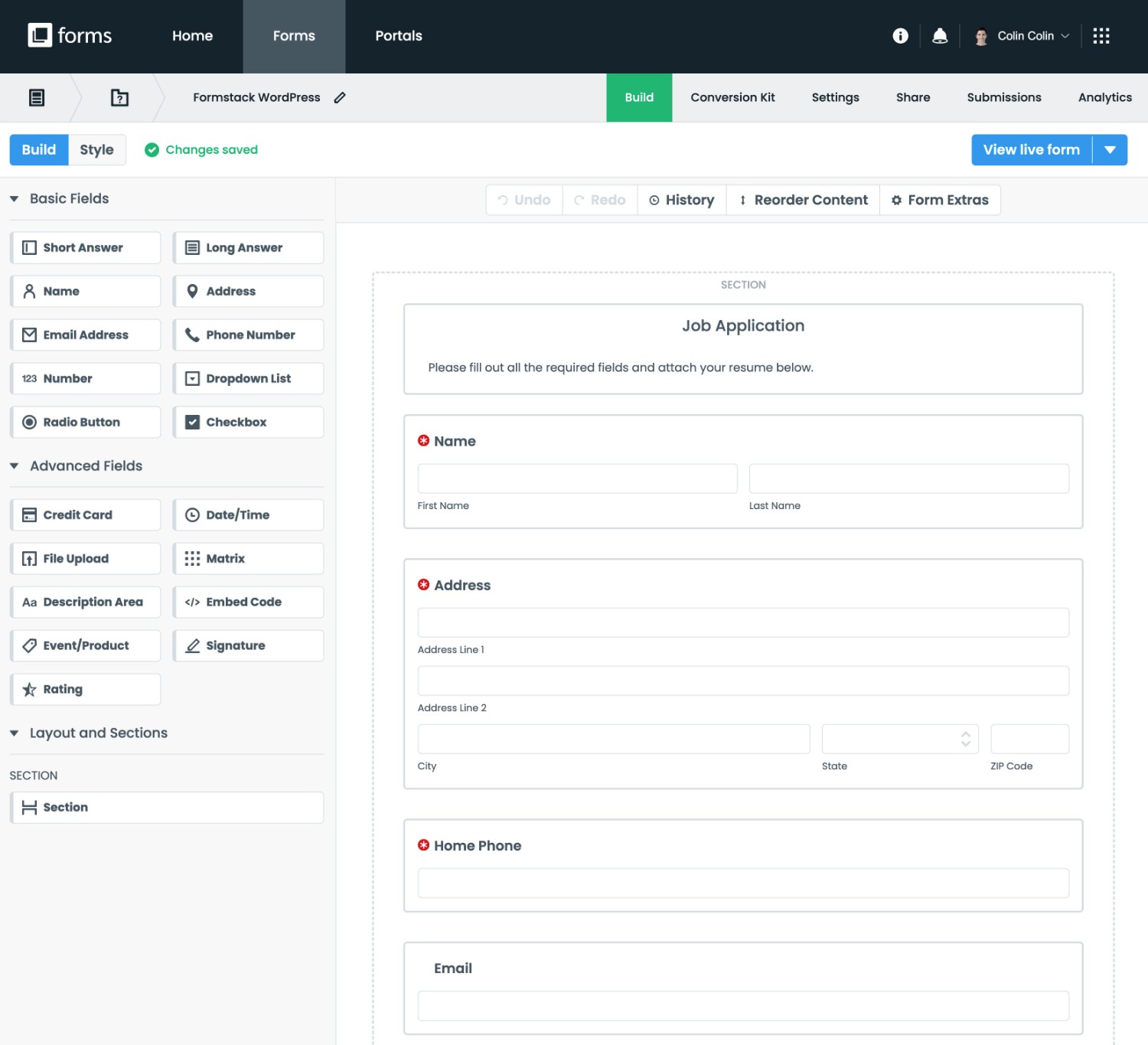
Pricing
Formstack only offers premium plans, though there is a 14-day free trial. For forms, the plans start at $59 per month for up to 20 forms and 1,000 submissions per month.
10. WS Form

Since its launch in 2020, WS Form has quickly built up a strong feature list and gained a good reputation for flexibility, which has made it a popular option with web developers.
It uses a similar pricing model to Ninja Forms, where you can purchase individual add-ons for specific features or get a bundle of some/all add-ons for one price.
Key Details
- Types of forms: WS Form is flexible and lets you build most types of forms, from simple forms to more advanced use cases.
- Integrations with other services: WS Forms has dedicated integrations for 80+ services including payment processors, email marketing services, CRMs, and more. There’s also a Zapier integration, as well as a webhook action that lets you push data to other services using webhooks.
- Third-party add-on marketplace: WS Form doesn’t have a very large third-party extension marketplace, though you will find some.
- Support: With a paid license, you get access to one-on-one ticket support.
Form Builder Interface
WS Form’s builder is generally easy to use and lets you arrange everything using drag and drop. It doesn’t have a live visual preview like some other tools, but you can easily preview your form by clicking a button.
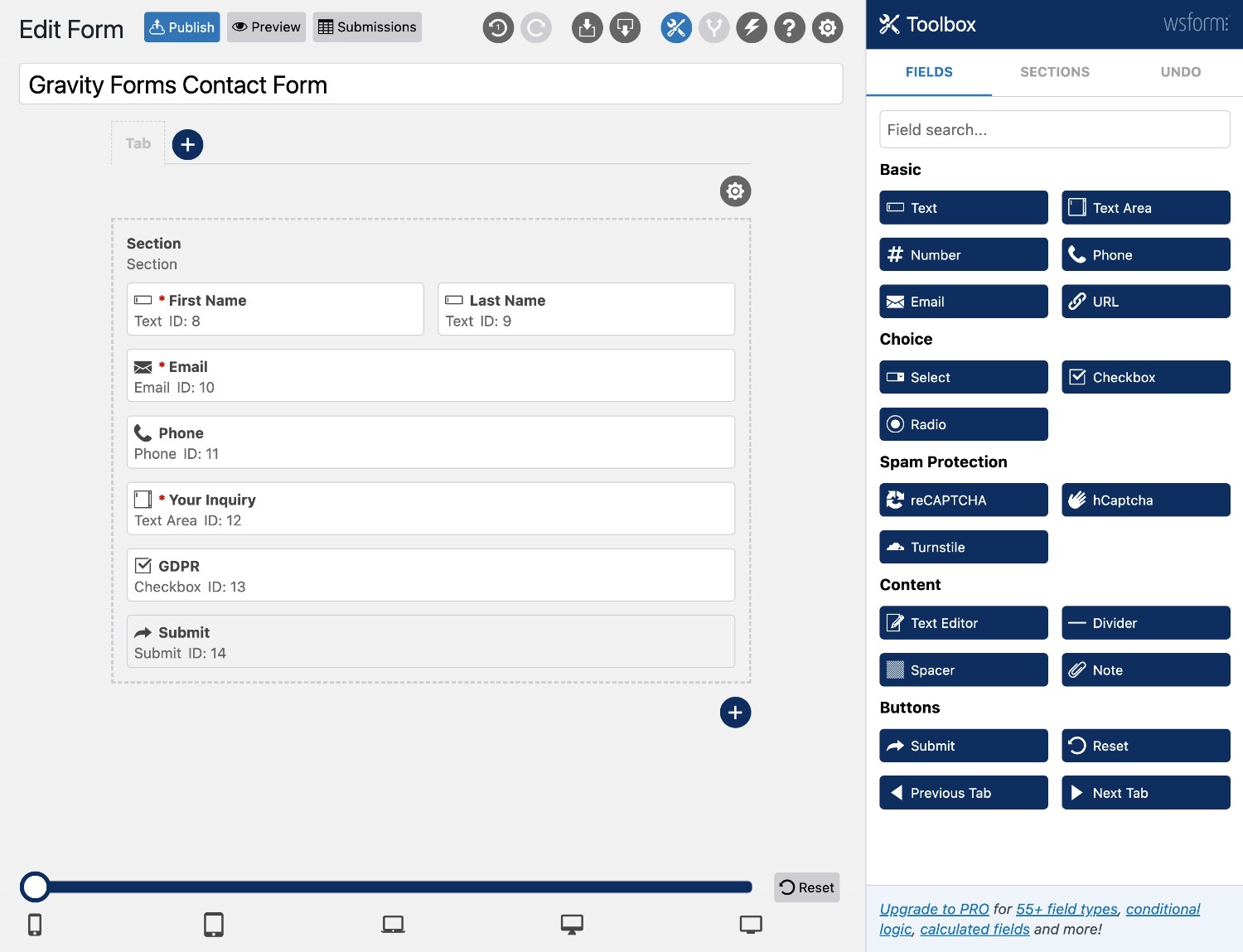
Pricing
WS Form has a free version at WordPress.org that can work for simple forms.
To access premium add-ons, you can purchase individual add-ons ranging from $19-$39 each.
Or, you can purchase bundles of add-ons, with three different license options starting at $59 and ranging up to $249.
11. Contact Form 7

Contact Form 7 is one of the oldest and most popular form plugins out there.
The user experience is not as nice/modern as most of the other form plugins on this list. There’s no drag-and-drop form builder and everything about building forms just generally feels pretty dated.
However, if your budget is $0 and you’re looking to build advanced forms without spending any money, Contact Form 7 is probably the best option you’ll find.
While the core Contact Form 7 plugin is pretty basic, there are tons of third-party extension plugins that add new features (and many of these plugins are available for free at WordPress.org). If you’re willing to put together your own stack from these third-party plugins, you can access a lot of functionality.
Key Details
- Types of forms: The core plugin really only works for contact forms and simple forms. But if you’re willing to use third-party extensions, you can build pretty much any type of form.
- Integrations with other services: The core plugin only integrates with Stripe and Brevo, so you’ll need third-party add-ons for most integrations.
- Third-party add-on marketplace: Along with Gravity Forms, Contact Form 7 also boasts one of the largest third-party add-on marketplaces among all form plugins.
- Support: Because there are no paid licenses, you’ll need to rely on community support at the WordPress.org support forums.
Form Builder Interface
Contact Form 7 does not offer a drag-and-drop builder. Instead, you’ll need to control form fields using shortcodes and parameters, which is a lot less user-friendly than most other form plugins.
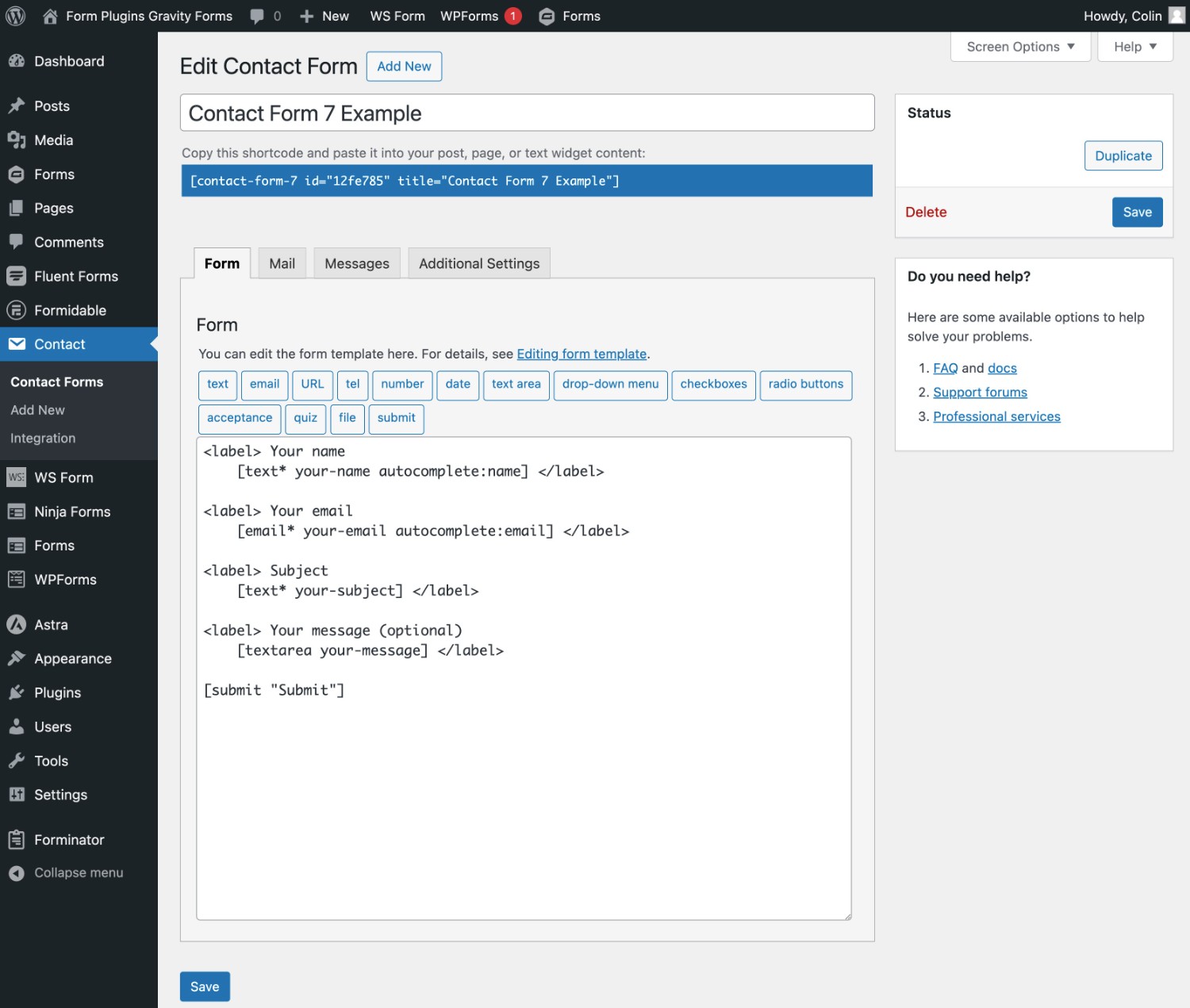
Pricing
The Contact Form 7 plugin is 100% free and available at WordPress.org. You can also find a bunch of free third-party add-on plugins at WordPress.org.
However, depending on the specific features that you need, you might need to pay for some premium third-party add-on plugins, which vary in cost.
12. Jetpack Forms
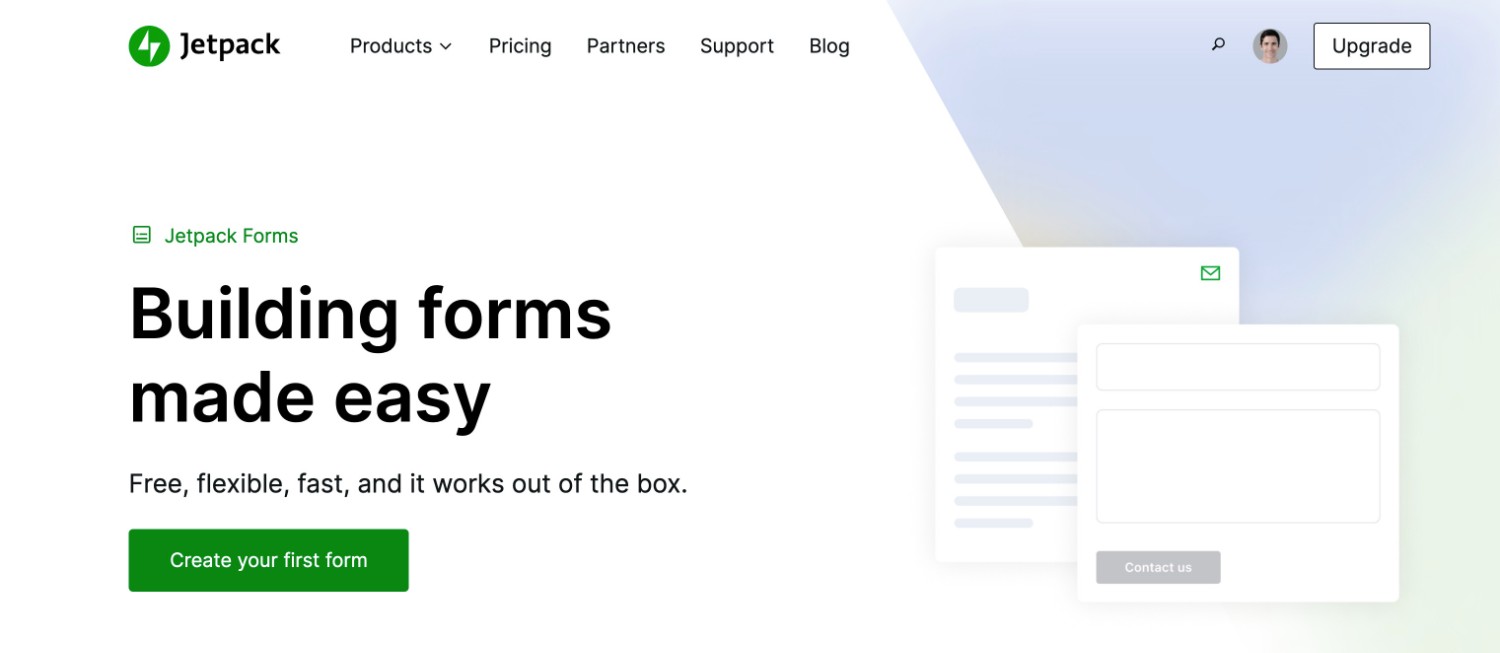
Jetpack Forms is a form feature that you can access as part of Automattic’s Jetpack plugin. That is, it’s not a standalone form plugin.
It’s not really an all-purpose form builder like most other plugins. Rather, it’s primarily focused on contact forms and lead gen forms, especially because it lacks the detailed integration support of other plugins.
It does have a unique setup process that lets you work directly from the block editor, including letting you use AI to help generate your form.
Key Details
- Types of forms: Jetpack Forms is primarily for contact forms and lead gen forms, though you have some flexibility here. Jetpack also has a separate payments feature that lets you create payment forms, though it’s not part of the Form block.
- Integrations with other services: Jetpack Forms supports a few notable integrations (such as Salesforce, which is in beta). But in general, integrations are not a strong point and your options are limited.
- Third-party add-on marketplace: There’s not really a third-party add-on marketplace for Jetpack Forms.
- Support: If you have a paid Jetpack plan, you can get email support. Otherwise, you’ll need to rely on the community support forum.
Form Builder Interface
There’s no separate form builder interface. Instead, you’ll set everything up using Jetpack’s Form block.
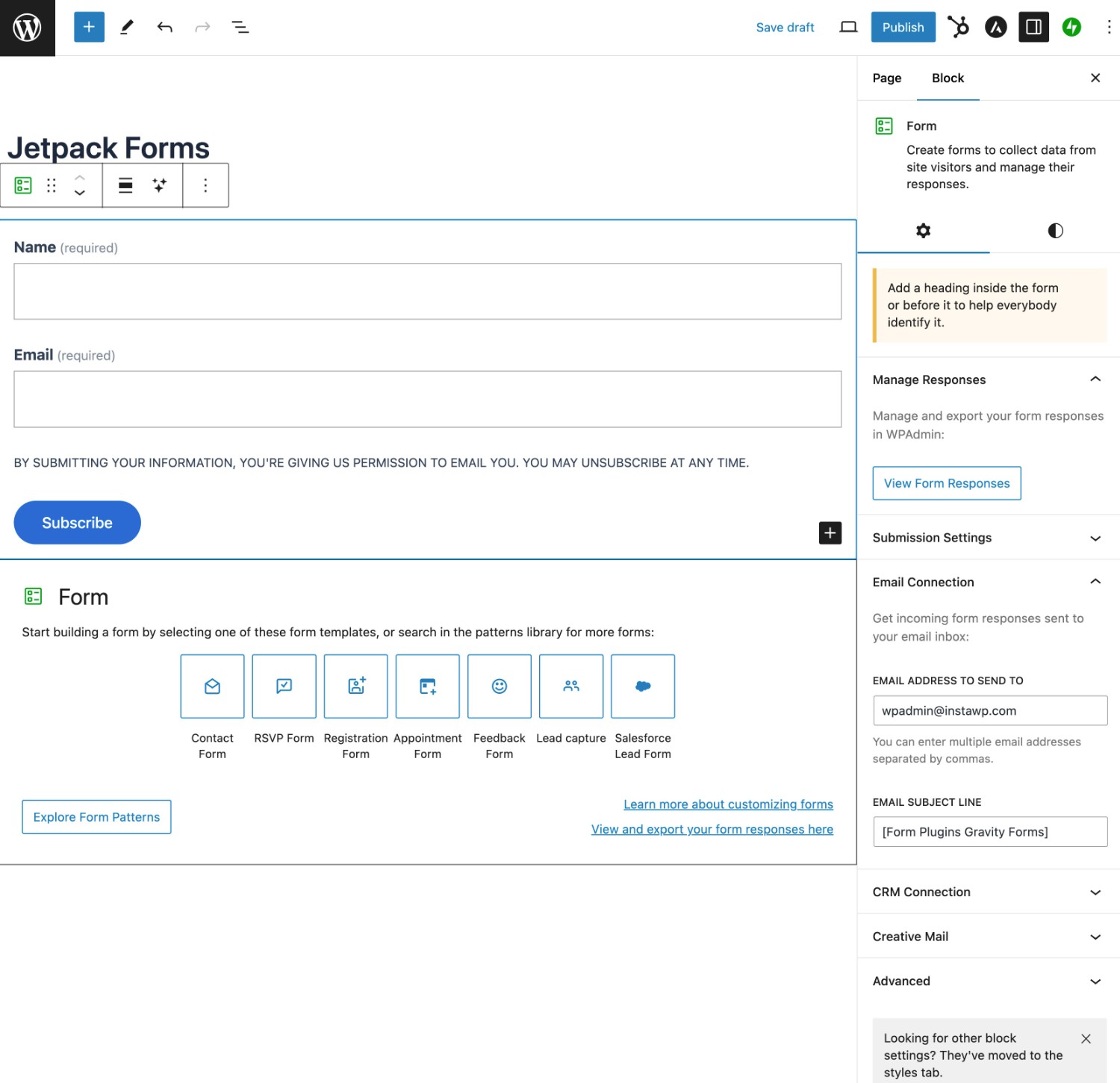
Pricing
While the Jetpack plugin offers a number of premium licenses, you can access the form functionality with just the free version.
However, if you want to use the Payments block, you should be aware that the free version of Jetpack adds a 10% transaction fee to any money that you collect.
13. HubSpot Forms

HubSpot is probably best known for its customer relationship manager (CRM). But, alongside that, it includes a bunch of other connected features, including a form builder that you can access from your WordPress dashboard using the HubSpot plugin.
The most unique thing about this plugin is that all of the form submissions will automatically feed into the HubSpot CRM. If you’re already using the HubSpot CRM (or want to start using it), that’s really convenient.
Key Details
- Types of forms: HubSpot Forms is primarily just for contact forms and lead gen forms, though it also works for customer support forms.
- Integrations with other services: You can connect to third-party services through the HubSpot CRM, but you can’t directly connect your forms like you can with most other form plugins.
- Third-party add-on marketplace: There’s not a third-party add-on marketplace for the form plugin, but you can find lots of third-party extensions for HubSpot itself.
- Support: All paid plans get support via chat and email, while higher-tier plans get phone support. Free users only get community support.
Form Builder Interface
While HubSpot lets you create forms from your WordPress dashboard using premade templates, you’ll need to work from the HubSpot website to actually customize the form fields using its drag-and-drop builder.
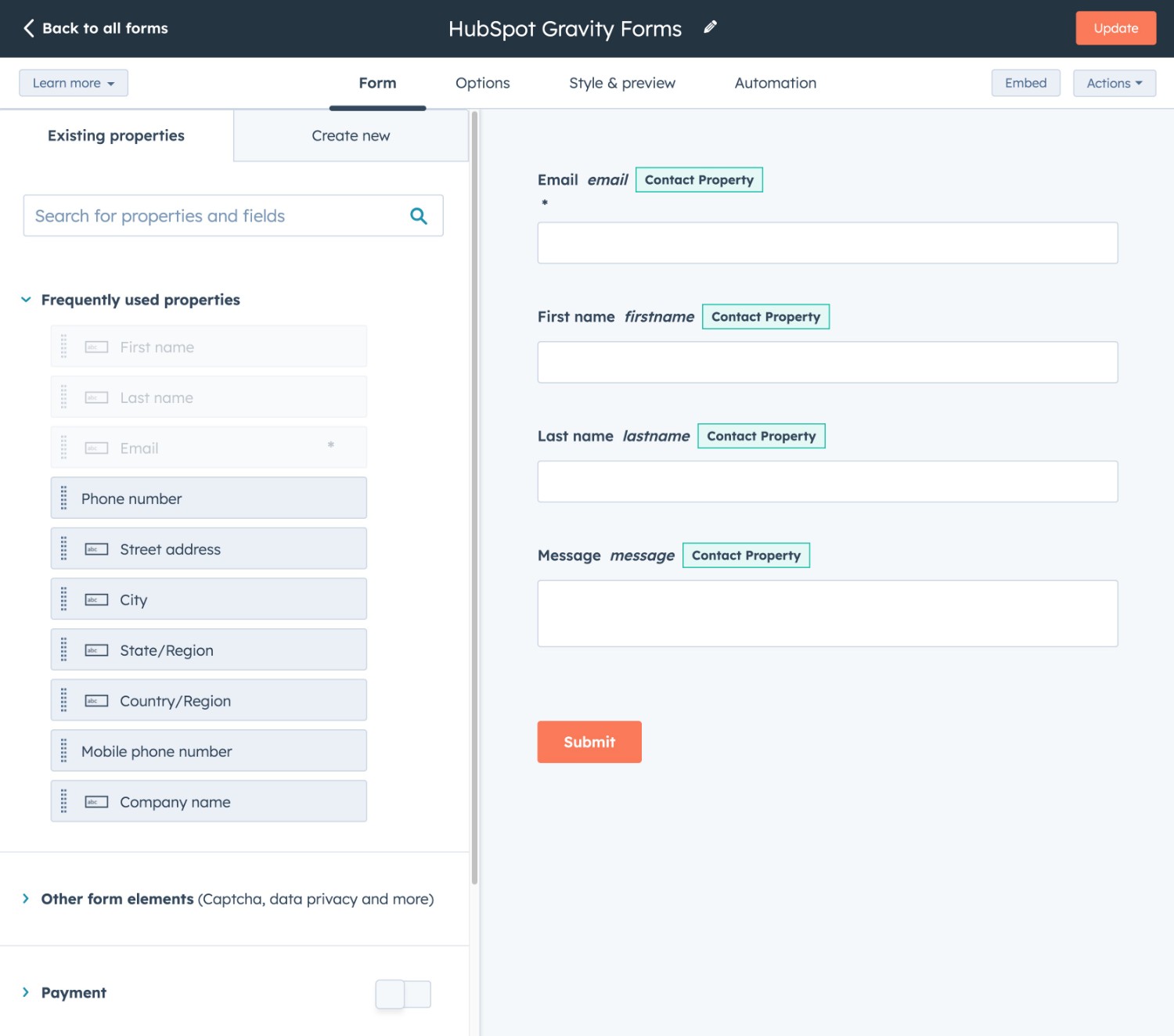
Pricing
The HubSpot form builder is free to use, as is the core HubSpot CRM functionality. There are paid plans for more advanced marketing, sales, and customer support features.
14. Happyforms

Happyforms is a freemium form builder plugin that was developed by the same team behind The Theme Foundry.
One of the most unique things about this plugin is its form builder interface, which looks a lot like the WordPress Customizer (what you use to customize most non-block WordPress themes).
However, you need the premium version to view form submissions in your WordPress dashboard, which is an important feature that most other free form plugins offer.
Key Details
- Types of forms: You can use it for most essential form types, including contact forms, lead gen forms, payment forms, and more.
- Integrations with other services: Happyforms integrates with most “big name” services, including Zapier. However, it’s generally more limited than many other plugins. For example, it only supports PayPal and Stripe for payment forms.
- Third-party add-on marketplace: The third-party add-on marketplace is quite limited and not many exist.
- Support: With a paid license, you get dedicated support via email.
Form Builder Interface
As we mentioned above, the Happyforms editor looks a lot like the classic WordPress theme customizer interface. You have a live visual preview of your form/website on the right and a sidebar on the left where you can control all of the form fields and settings.
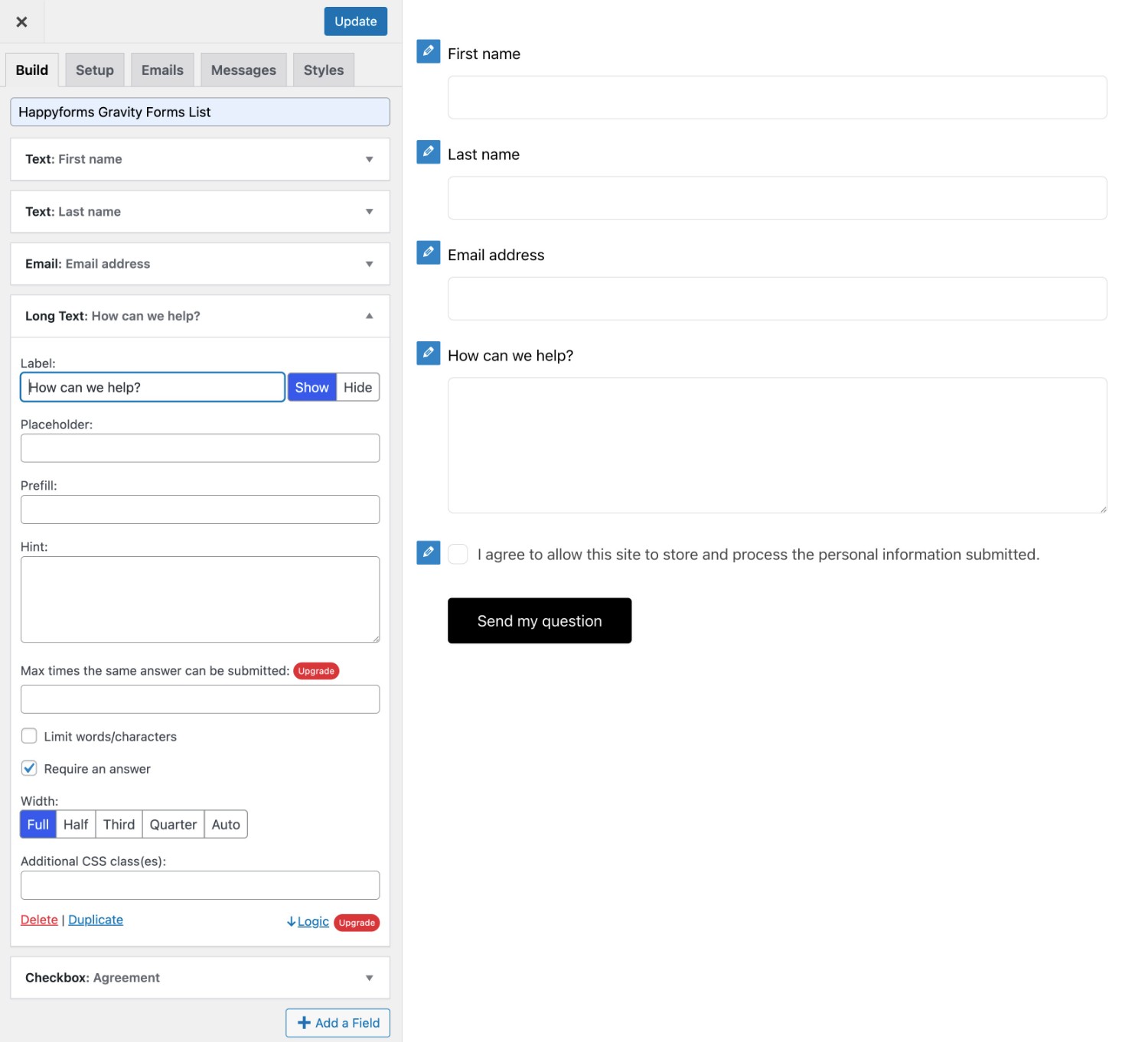
Pricing
Happyforms has a limited free version that’s available at WordPress.org.
Paid plans start at $89 for “starter features” or $159 for “all features”.
15. Kadence Blocks

Kadence Blocks is another plugin that’s notable for the approach that it takes to building forms. Like Jetpack, it lets you fully build your forms directly in the editor using blocks, rather than having a separate interface.
Also like Jetpack, it’s not just a form plugin – it also includes a number of other custom blocks and enhancements for the editor.
Key Details
- Types of forms: It’s primarily for contact forms or other basic forms, though it does offer integrations for some email marketing services and CRMs.
- Integrations with other services: It integrates with some email marketing services and CRMs, but the selection is much more limited than most form plugins.
- Third-party add-on marketplace: There don’t seem to be any third-party add-ons for the form block.
- Support: With a paid license, you can get direct ticket support.
Form Builder Interface
Rather than having a separate form builder interface, you’ll set your forms up directly from the block editor.
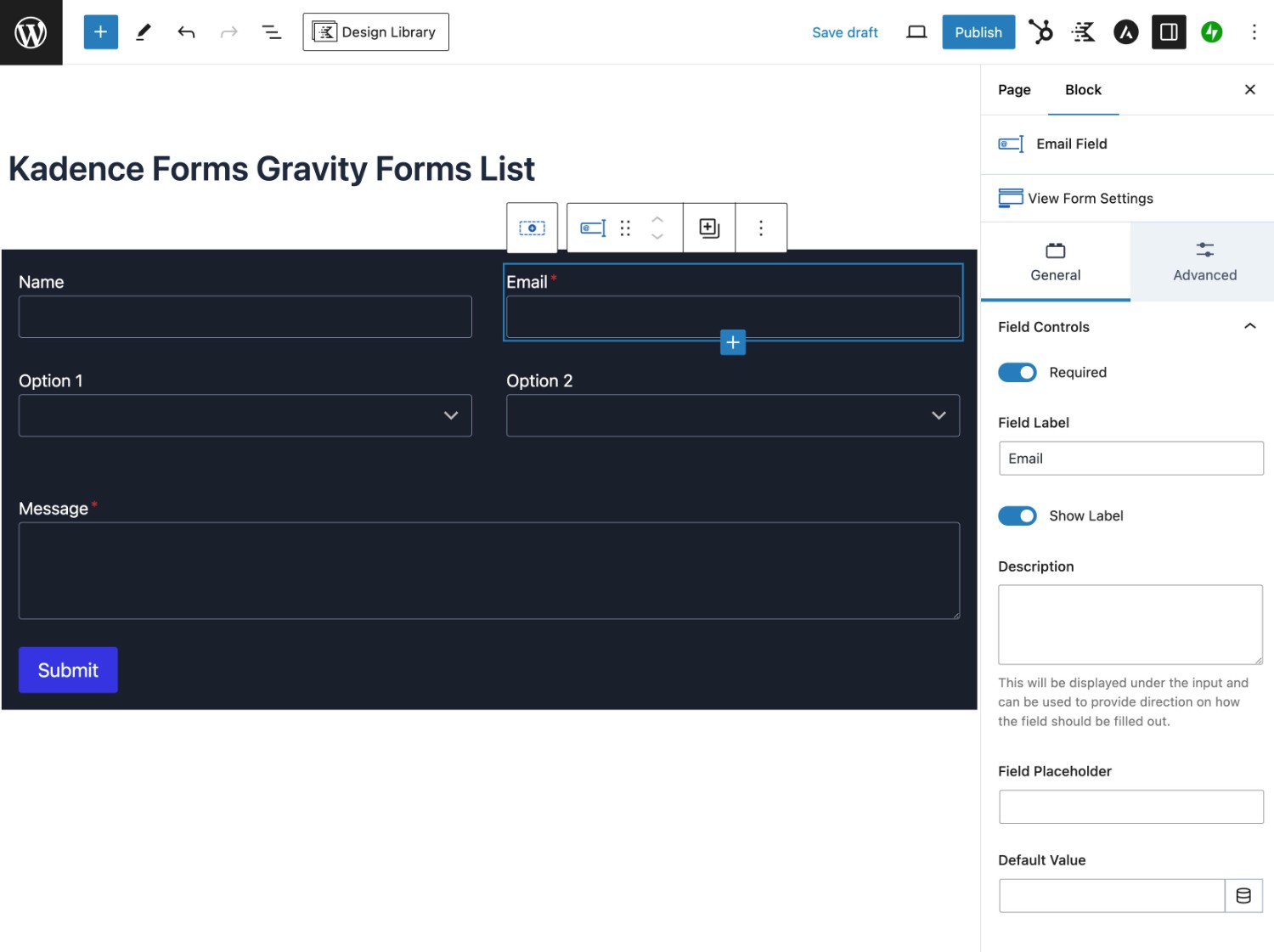
Pricing
Kadence Blocks has a free version at WordPress.org that includes the form block.
However, you’ll need the paid plan to access some integrations, as well as advanced features like conditional logic. Kadence Blocks Pro costs $89.
Get Started With the Best WordPress Form Plugin for Your Needs
That wraps up our thoughts on the top form plugins to consider for your website. Choosing the right plugin will depend on your budget, along with your specific needs, such as the types of forms you’re building, the integrations that you want, and so on.
If you just want to create a basic contact form without any integrations beyond sending yourself a notification email, you’ll probably be ok with one of the free form plugins on this list. Just make sure to look for one that lets you save form submissions and view them in your dashboard (which most, but not all, do).
If you want to go beyond that, we think Gravity Forms makes a great starting point. It’s easy to use, lets you build pretty much any type of form, includes essential features like conditional logic and calculations, and integrates with a bunch of different services.
If you ever need to go beyond the built-in features, Gravity Forms also has a huge marketplace of third-party add-ons, along with lots of features for developers to extend the plugin (including a PHP API and REST API).
You can purchase your license today to get started, with prices beginning at just $59.
Or, if you want to try before you buy, you can create a free, fully functioning demo site here.

If you want to keep up-to-date with what’s happening on the blog sign up for the Gravity Forms newsletter!
